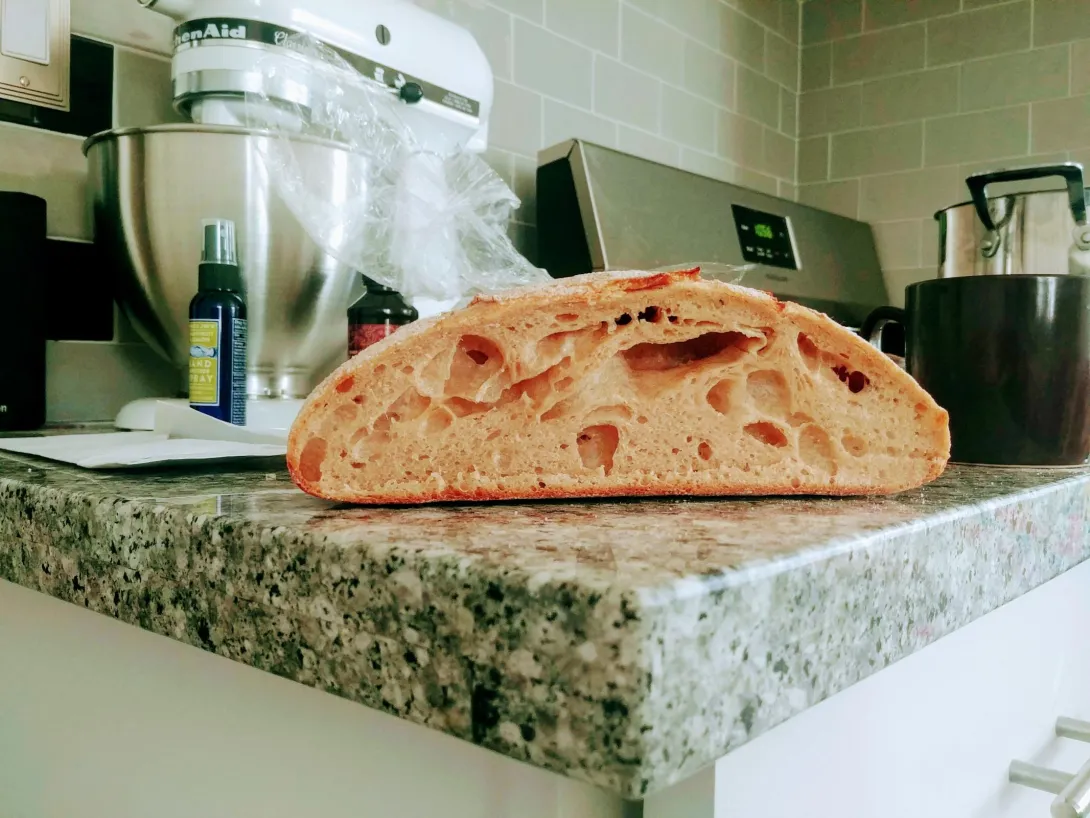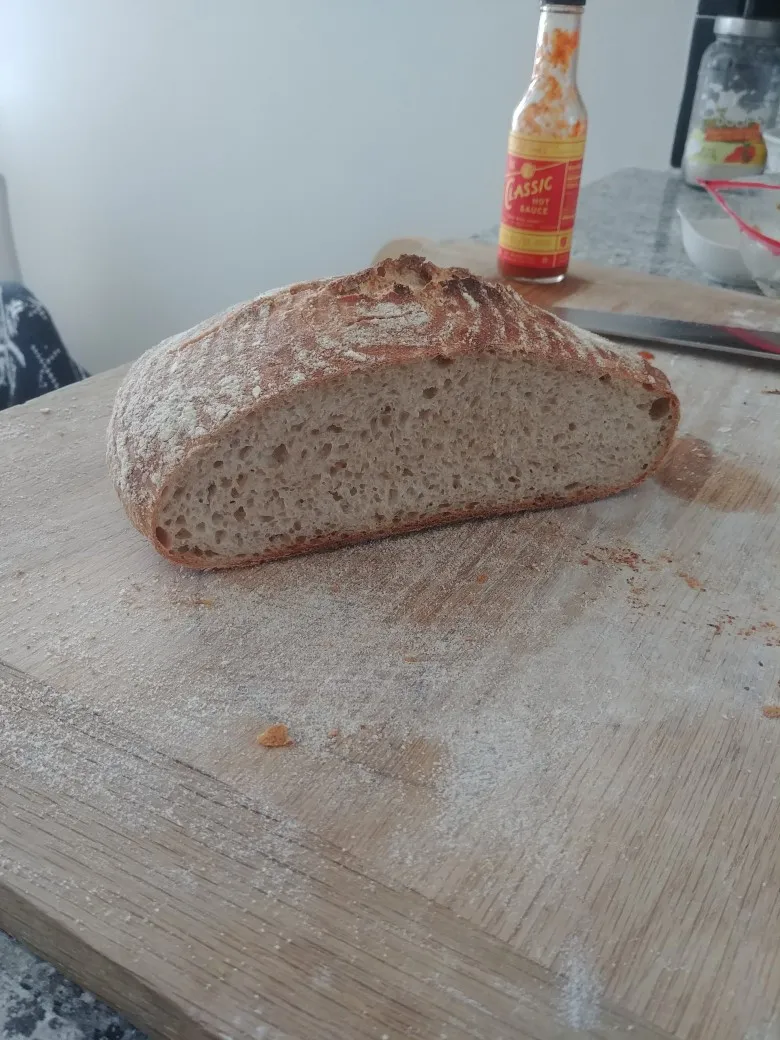
Hey all,
I'm a relative newcomer to sourdough (first attempt was probably a month ago). I've made probably 5 batches yielding 2 loaves each. The first 4 were either the Overnight Country Blonde or Brown from FWSY. The last one that I made yesterday was made using this recipe for Tartine's Country Bread. Each time I followed the recipe pretty much to the letter. All loaves have turned out... fine. Great flavor, and I've never had any go uneaten, but I'm not satisfied with the structure of the loaves. They all end up turning out rather flat (compared to loaves made with only packaged yeast or one of Forkish's hybrid loaves) with big giant holes alongside tiny little ones.
My question is, how do I go about getting these loaves to puff up more? I don't know if my levain isn't active enough or if I'm either over or under-proofing the loaves or...? I know nobody will be able to provide a definitive answer, but maybe some ideas of things to tweak and experiment with going forward?
You're either jumping the gun with the levain build or at the bulk ferment stage. Or your starter is not firing on all cylinders.
I could see that happening for sure... especially since this time of year it's a struggle to find any place in our house that's warmer than 70 degrees. Maybe I'll have to practice some more patience.
What are some indications of a starter not being ready to use? I always keep it in the fridge and wake it up a day or two before mixing the dough. So out of the fridge it gets two feedings before use.
Look for peaked and just beginning to fall. It should smell ripe too. If your starter is working fine then it's the levain or bulk ferment you're over estimating. Levain should be full of bubbles and peaking (this is not the only rule but a good one to start off with) and the bulk ferment is done when the dough is billowy, areated and there's a good matrix of bubbles. Blisters on the skin of the dough is also a good sign. If temps are falling below 70°F then you will be experiencing a significant slowing down. 75-78°F is a good temp to aim for. If not possible then give the dough all the time it needs. Watch the dough and not the clock.
Hey jrellet,
I'm actually jealous of your loaf's huge holes up top. I've been following Tartine's recipe and 4 times in, I'm still getting no holes at all. It makes great sandwich bread, but that's not what I'm going for. The main advice I've been following is to stick with only one recipe until you get it down. So for you, keep using Tartine's recipe and tweak only one or two things each bake so you can identify what is causing your flatter bread. For example, for my next bake, I'm going to use bread flour (for more gluten, which might help the structure). I also haven't been diligent with feeding my starter. I'm currently working a sporadic schedule, so I sometimes miss the morning feed and have to wait until the evening (it's best to feed it around the same time each day).
I know that loaf isn't exactly what you're going for, but it still looks delicious!
Thanks for the input and the complement! It's definitely a great loaf of bread (which is nearly gone now).
I was actually thinking about switching to bread flour myself to help with the structure of the loaves. I generally keep my starter in the fridge and wake it up a day or two before baking. Maybe that is causing issues too...
Looks under fermented. You are brave to try a Tartine recipe so early in your baking career.... lol As a rookie why not start with an easier recipe? Get your starter really going and then try this one? : http://www.wildyeastblog.com/my-new-favorite-sourdough/comment-page-2/
It's a fabulous recipe and simple to do and delicious. And confidence building. Just make sure your starter is nice and active.
hester
LOL I guess I didn't realize it was a big leap to go for that recipe. I started baking bread about 6 months ago and I've just been baking my way through Flour Water Salt Yeast, and the only thing I got hung up on were the pure levain doughs that turned out just like the Tartine loaf pictured above. I figured I'd try the Tartine since it looked similar to what I was already trying with some subtle differences that maybe would work better for me.
I'll give that bread a shot for sure! Looks fantastic.
Do you have any tips for what to look for in an active starter?
For me, if it's 100% hydration starter I like to make sure there are a lot of bubbles on top, and sides. If it's a stiffer starter it should have grown, expanded, etc. I'm linking below a nicely explained starter creation and maintenance.
Here you go: https://www.theperfectloaf.com/7-easy-steps-making-incredible-sourdough-starter-scratch/
Good luck
hester
I just made a couple loaves using that recipe and I'm really happy with how they turned out. Thanks for the tip!
Image

nicely done. I bet they taste delicious also. It's a great recipe. I tried perfecting it b/f advancing. Looks like you're ready to move ahead.
Well done.
hester
p.s. Makes delicious toast also.
(instead of baked) I would say, "Hey, this looks good enough to call it the end of bulk fermentation. So now shape that puppy and let it have a final proof." In other words, baking it at this stage "freeze framed" the crumb near the end of the bulk ferment.
I would make sure your starter is as active as you can first. And calibrated. Then you can determine whether a recipe will work for your starter or not, and adjust recipes as you need to. If you already know that your starter peaks at 6 hours and more than doubles at it's peak (or some similar statistic), then ignore this post you are already on to it. Otherwise read on.
1. Keep it out of the fridge for a few weeks while you do this.
2. Feed it at least every 12 hours. Better yet, feed it every time just after it definitely peaks and starts to fall. Frequent feedings favour yeast. I wouldn't worry about sourness in your starter at this point (there's plenty things you could do after you are sure of your starter, and an argument on every side of the issue, but if the leavening power is in question you need to favour yeasts first and foremost).
3. Always feed it the SAME FLOURS in the SAME RATIO at the SAME HYDRATION. Starters hate reconfiguring to a new environment, and will slow way down with long lag times any time you change the routine.
4. Feed it about 2:3:3, or if you are committed to a particular feeding ratio then stick to your ratio.
5. Measure it's performance every day or two (or every time if you are obsessed like I am). At about 20C room temperature, most active starters will more than double within six hours. If it peaks out at 9 hours or so, keep feeding as described above.. as it improves it will peak sooner (usually).
6. After a week or two if it still peaks late (9 hours or so), then you just happen to have a permanently slow starter. Teresa Greenway has a 120 year old starter that still runs slow.
Also I find if I chill my starter, I have to feed it two or three times before it's behaving properly again. I can't just use it for bread right away. [edit: ah yes you mentioned you do this.]
Good luck!
Thank you for the starter tips! When you mention the feeding ratio 2:3:3, is that 2 parts starter, 3 parts flour, 3 parts water?
I'm not sure what the convention is on the order. I have been using starter:water:flour because that's the order I mix them in, but others might be using starter:flour:water. Maybe someone will drop by and school us. In this case, it doesn't matter, water and flour are both the same (100% hydration). 1:2:2 is also a good feeding ratio. And even big ratios like 1:10:10 work fine and sometimes is the best way to fix a problem starter. Going the other way, e.g. to 1:1:1 is IMHO a bad idea.
Gotcha. I've been sticking to what Forkish recommends (I think 1:5:4) and that seems to be pretty good, but a lower amount of flour would be more economical for sure.
Just to be clear, 1:1:1 is what I happen to use when I measure/calibrate a starter. "6 hours to peak" is based on that ratio. If you feed more, like 1:5:4, I would expect it would take longer to peak. Let's calculate it, shall we?
(I changed my orig reply to 2:3:3 because I think that's a better feeding, but it throws off the "6 hour" expectation, so I was wrong in my post, sorry about that). Anyhow, let's carry on with some math.
Here is a basic straight line formula that presumes the starter lags (does nothing) then immediately starts doubling at some rate into the food supply, and that when it runs out of food supply we presume it has 'peaked in the jar'. It's crude, but functional:
time_to_peak = lag_time + doubling_time * log_base2( (starter +water +flour) / starter )
rearranged:
doubling_time = (time_to_peak - lag_time) / log_base2((starter +water +flour) / starter)
So in a '6 hour peak in the jar' starter fed at 1:1:1 at 0:45 lag, the culture doubles into the food supply every 3.31 hours, and runs out of food at 6 hours.
Using that same doubling time and lag time at 1:5:4, we would expect it to take 11.75 hours to double in the jar. [Wow, that's very convenient for feeding every 12 hours... Forkish must have worked that out intentionally].
Lag time varies, but is around 45 minutes to an hour, moreso if you are making larger changes to the environment. If you build a levain that is quite different makeup than the starter, than I bump up lag time by 30 minutes or so.
I hope that makes some sense. And I hope I'm not too far off on what a "typical" starter behaves like.
Ok that's making sense. I'm keeping an eye on my starter today. Here's when I first mixed it out of the fridge (Forkish recommends a 2:5:4 ratio of starter:flour:water to wake it up after the fridge) vs 7 hours later (just now).
That's more than double, meaning the culture doubles in less than 3.66 hours. Your starter is fine. Carry on.
It's starter:water:flour
it depends on the author and can vary but starter is usually first. :)
It's done as a table and can be however the author wishes. But given as a ratio, e.g. 1:2:3, with nothing else, it's accepted as starter:water:flour.
[tongue in cheek]
The other thing that might have gone wrong is that you expected to get reliable useful information out of the New York Times.
[/tongue in cheek]